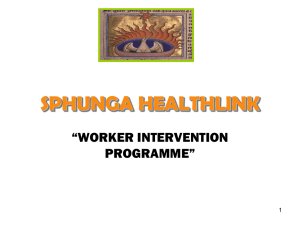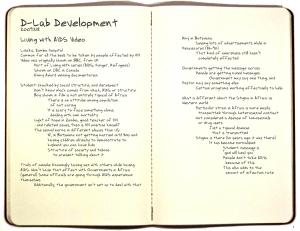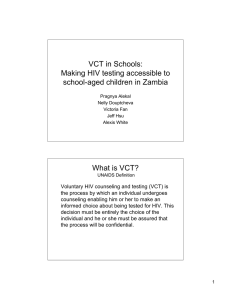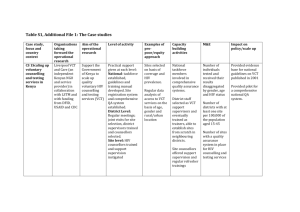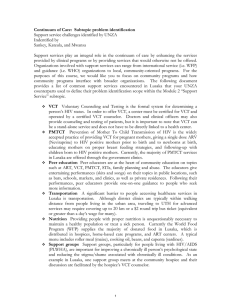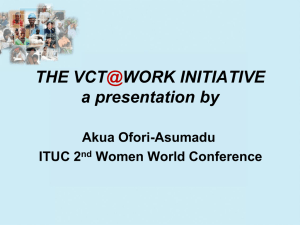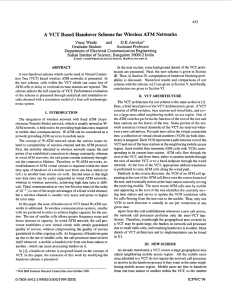Support Services: VCT and Education in Primary and Secondary... 7-November 2005
advertisement
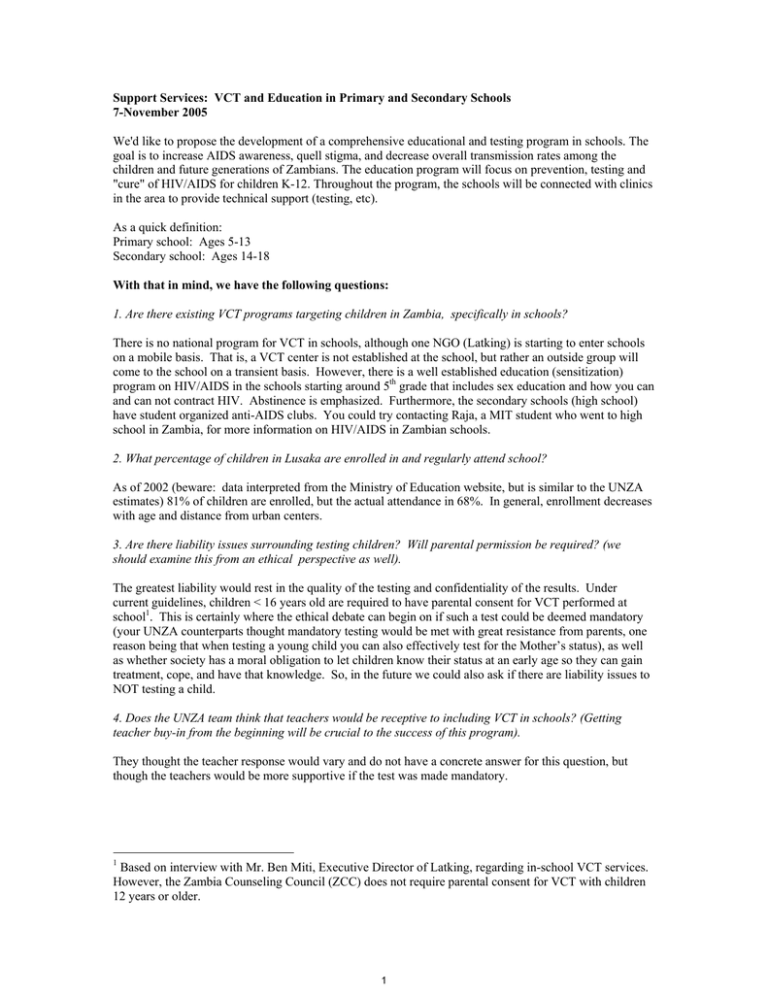
Support Services: VCT and Education in Primary and Secondary Schools 7-November 2005 We'd like to propose the development of a comprehensive educational and testing program in schools. The goal is to increase AIDS awareness, quell stigma, and decrease overall transmission rates among the children and future generations of Zambians. The education program will focus on prevention, testing and "cure" of HIV/AIDS for children K-12. Throughout the program, the schools will be connected with clinics in the area to provide technical support (testing, etc). As a quick definition: Primary school: Ages 5-13 Secondary school: Ages 14-18 With that in mind, we have the following questions: 1. Are there existing VCT programs targeting children in Zambia, specifically in schools? There is no national program for VCT in schools, although one NGO (Latking) is starting to enter schools on a mobile basis. That is, a VCT center is not established at the school, but rather an outside group will come to the school on a transient basis. However, there is a well established education (sensitization) program on HIV/AIDS in the schools starting around 5th grade that includes sex education and how you can and can not contract HIV. Abstinence is emphasized. Furthermore, the secondary schools (high school) have student organized anti-AIDS clubs. You could try contacting Raja, a MIT student who went to high school in Zambia, for more information on HIV/AIDS in Zambian schools. 2. What percentage of children in Lusaka are enrolled in and regularly attend school? As of 2002 (beware: data interpreted from the Ministry of Education website, but is similar to the UNZA estimates) 81% of children are enrolled, but the actual attendance in 68%. In general, enrollment decreases with age and distance from urban centers. 3. Are there liability issues surrounding testing children? Will parental permission be required? (we should examine this from an ethical perspective as well). The greatest liability would rest in the quality of the testing and confidentiality of the results. Under current guidelines, children < 16 years old are required to have parental consent for VCT performed at school1. This is certainly where the ethical debate can begin on if such a test could be deemed mandatory (your UNZA counterparts thought mandatory testing would be met with great resistance from parents, one reason being that when testing a young child you can also effectively test for the Mother’s status), as well as whether society has a moral obligation to let children know their status at an early age so they can gain treatment, cope, and have that knowledge. So, in the future we could also ask if there are liability issues to NOT testing a child. 4. Does the UNZA team think that teachers would be receptive to including VCT in schools? (Getting teacher buy-in from the beginning will be crucial to the success of this program). They thought the teacher response would vary and do not have a concrete answer for this question, but though the teachers would be more supportive if the test was made mandatory. 1 Based on interview with Mr. Ben Miti, Executive Director of Latking, regarding in-school VCT services. However, the Zambia Counseling Council (ZCC) does not require parental consent for VCT with children 12 years or older. 1 5. Are there any mandatory testing initiatives (not necessarily geared towards children...it can be military, govt employees, pvt companies etc.) already implemented by the Government of Zambia or other agencies? Yes. The military requires testing as do some private companies (CelTel, the Verizon of Zambia, is one such company). Also, there was a recent political debate about whether presidential candidates should go for testing. Many people felt they should because it would encourage more people to go, but in the end the politicians declined. Along those lines, a recent news article reported that 56% of the Ministers of Parliament have been tested. Health workers (doctors, nurses, clinical officers) are not required to be tested. 6. Do you believe that HIV testing in a school environment will better or worsen potential stigma? We speculated that stigma in schools would initially worsen particularly if information on a child’s status is not kept confidential or if school officials have full access to the information. However, if the VCT service is kept independent from the school that issue could be resolved and the long-term benefit of children being taught and experiencing VCT at an early age would ultimately reduce stigma as those children grew to be adults. 7. What are some of the ethical considerations you foresee in the implementation of such a system in Zambia? • • • • At what age should testing of a child begin? If a child is HIV positive, is it better for that child to know at a young age so that they can learn to cope or at an older age when they are more independent? When should parental consent be required and what are the parental rights for such a policy? Can you neglect the 30% or more of children that are not in school or others in the same community? Is VCT for children a societal obligation for every child to know their status (no longer Voluntary Counseling and Testing) or should there always be a choice? 8. How many schools (junior high and high school) are there in Lusaka? Are there health centers in these schools, and if yes, do they currently run any educational programs? What is the Zambian view on free condom distribution to high schoolers? Nationwide there are 4558 schools (as of 2002). As an estimate that might mean there are roughly 900 schools around Lusaka, but that still seems high. None of the government schools have health services (nurse or clinic), but the school curriculum includes health education. For AIDS education the emphasis is on abstinence, so condom distribution probably would not be very well accepted. General Points from UNZA • Community VCT programs should run in parallel to those in schools in order to capture the subgroup of children not in school, as well as parents and community members not being tested. This does not have to be the consideration of a school-specific program, but still needs to be addressed. • Determining the child cut-off age for when parental consent is required or if there is a minimum age for required testing is important to work out because school children span two distinct groups of people based on personal freedom and the potential mode of transmission. For younger children the mode of transmission can be assumed from the mother or as a result of sexual abuse. This child did not make a choice that put them at risk for acquiring HIV, but yet has to live with their status. Young adult may also have acquired HIV through sexual abuse or their mother, but there is the added mode of transmission from sexual activity. How should these different cases be treated? 2 MIT OpenCourseWare http://ocw.mit.edu EC.S11 Engineering Capacity in Community-Based Healthcare Fall 2005 For information about citing these materials or our Terms of Use, visit: http://ocw.mit.edu/terms.
